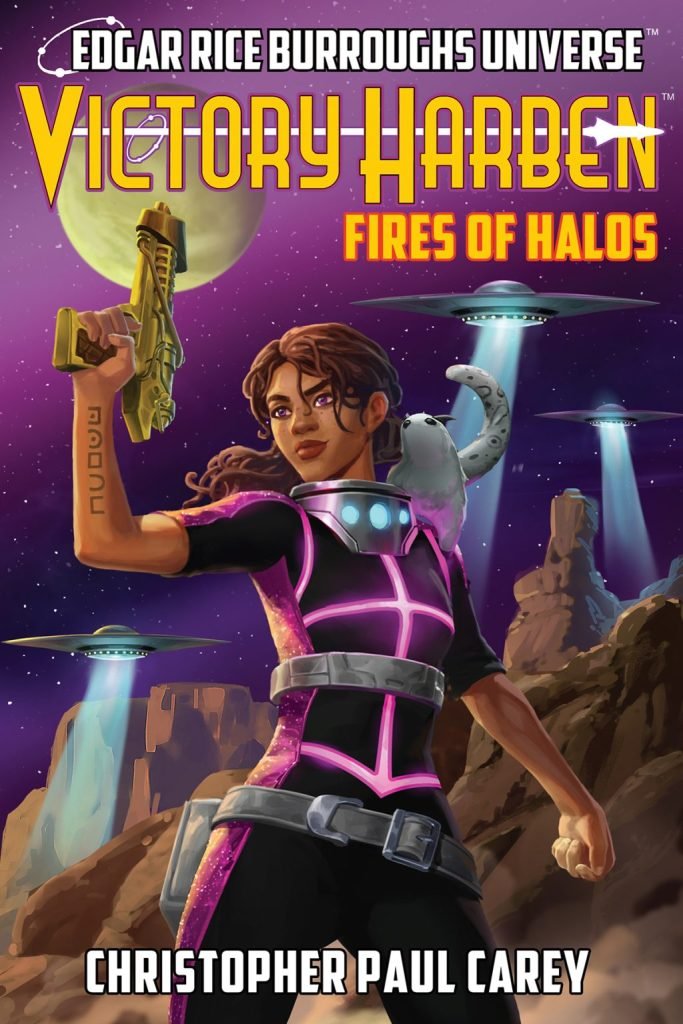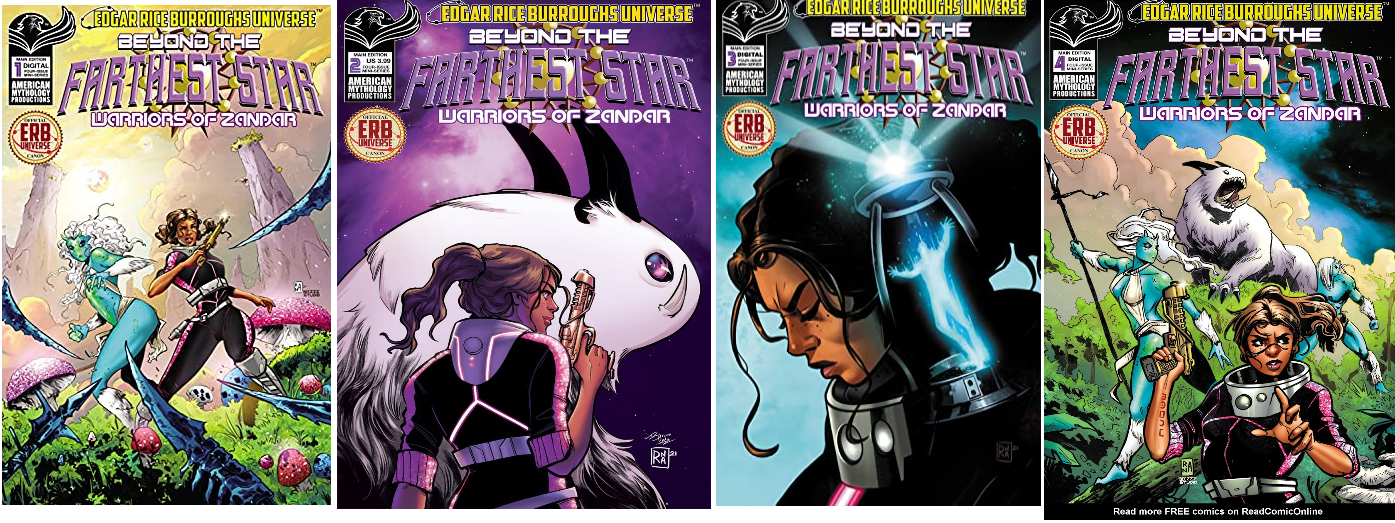Today I chat with author and friend Win Scott Eckert, as a part of my ongoing series featuring creative folks who will be appearing at Pulpfest 2025. Win is the editor of Myths For the Modern Age and three volumes of short stories featuring The Green Hornet, co-author with Philip Jose Farmer of The Evil in Pemberley House and The Monster on Hold, and author of Crossovers: A Secret History of the World, The Scarlet Jaguar, and the authorized Edgar Rice Universe canonical novels Tarzan: Battle for Pellucidar, and Korak At The Earth’s Core. He has also written short stories featuring classic characters like The Green Hornet, the Lone Ranger, the Avenger, the Phantom, Sherlock Holmes, the Domino Lady, Honey West, T.H.E. Cat, and Irma Vep. Win is a member of the International Association of Media Tie-In Writers, holds a B.A. in anthropology and a Juris Doctor.
Hi, Win! Thanks for taking some time to chat. I know you’re busy working on the second book in your Edgar Rice Burroughs Universe trilogy, the Dead Moon Super-Arc.
WSE: Hi, Anthony! Yes, Pellucidar: Land of Awful Shadow.
We’ll talk about the new book shortly, but my first question is more general. You’ve had a wonderful career writing in the worlds of Edgar Rice Burroughs, Philip José Farmer, the Green Hornet, The Avenger, Honey West, the Lone Ranger, and others. Talk to me a bit about your earliest memories of wanting to write these characters/in these worlds.
To be honest, I didn’t consider writing fiction until after I started my metafictional Wold Newton Universe site in 1997. My first forays were non-fiction (or rather, metafiction) essays which were writing about characters’ chronologies and family trees, rather than traditional fiction stories. It was only when Jean-Marc Lofficier suggested that I try my hand at straight fiction for his annual Tales of the Shadowmen anthologies that I considered it. This was in 2004.
What is your current writing process like? That is, are you a plotter, a “pantser,” etc.? Do you set daily wordcount goals? And has that process changed at all throughout your career?
I am not a “pantser.” I definitely outline, but at a high level. I know the beginning, middle, and most importantly, the end. Part of this is because it is generally required when writing for licensed properties (although requirements for licensed properties are on the spectrum of detail from “almost no detail, just a pitch” to a strict chapter-by-chapter outline). Even with a strict chapter outline, there is a lot of room for creativity as I actually write the chapters, as additional inspiration inevitably hits while I am writing. And sometimes the chapters end up getting moved around as I write, and so forth. So, the outline is not a strict contract, but rather a demonstration that I know where I’m going in the end, even if the path of getting there deviates from the outline. As for your other questions, when I am deep in a writing project, I do set wordcount goals. My process has not changed much in the last twenty years, with the exception that within the last five years or so I occasionally dictate some portions of a novel; it speeds up my writing, but I’ve also noticed that more errors are introduced which I sometimes fail to catch despite intense proofing, so I am a bit gun shy right now about dictating too much.
You’re on your third novel for the Edgar Rice Burroughs Universe (the first being Tarzan: Battle for Pellucidar in the “Swords of Eternity Super-Arc” that launched the Edgar Rice Burroughs Universe (ERBU), and the second being Korak at Earth’s Core, the first book in your “Dead Moon Super-Arc”). I’d love to hear a bit about how you came to write for ERB Inc., and how you crafted your pitch for the “Dead Moon Super-Arc.”
Shortly before Christopher Paul Carey joined ERB, Inc. as Director (now VP) of Publishing, I pitched a Korak novel to CEO Jim Sullos, which was accepted. Once Chris joined, and outlined his plans for the ERBU, to be kicked off with the “Swords of Eternity Super-Arc,” it was a no-brainer that a Tarzan novel was needed for that launch. I reworked my Korak pitch into a Tarzan pitch which became Tarzan: Battle for Pellucidar. After that, Chris and I still really wanted to do a Korak novel. I explained my idea to him in person at PulpFest, to which he burst out laughing, and said, “Let’s do it!”
Philip José Farmer wrote an article originally published in ERB-dom No. 57, April 1972. His ideas were worked into his mock biography, Tarzan Alive. The article has also been republished in my collection Myths for the Modern Age: Philip José Farmer’s Wold Newton Universe (MonkeyBrain Books), Pearls from Peoria (Subterranean Press), and The Man Who Met Tarzan (Meteor House). The article is entitled “The Great Korak-Time Discrepancy” and deals with how Korak, the son of Tarzan, impossibly ages about eight-ten years between the ERB books The Beasts of Tarzan and The Son of Tarzan. Farmer proposes an explanation, and there is another branch of fandom that proposes a different explanation. You can read the article online here. The “Dead Moon Super-Arc” will present a third, in-universe explanation.
We also wanted to explore as-yet untouched (or relatively untouched parts) of Pellucidar, the hollow world at the Earth’s core, and decided that the Dead World and the Land of Awful Shadow would be great settings for this trilogy.
What challenges have you encountered in moving Burroughs’ classic characters forward in time and in expanding the ERBU while still remaining true to his spirit and Burroughs’ original timeline and characters?
Honestly . . . not many. The biggest challenge is ensuring that all the writers’ stories remain consistent with each other, with no contradictions. That is one of the big selling points of the ERBU: the novels, stories, and comics are consistent both in continuity and in character with what ERB wrote, but they are all also consistent with each other. It’s not difficult to portray these characters as honorable and heroic. Perfect? No, of course not. I had a good time portraying Korak as less than perfect, and yet still heroic.
Without spoilers, what can you tell us about the upcoming second “Dead Moon Super-Arc” novel, Pellucidar: Land of Awful Shadow?
Yes! It takes place mostly concurrently with Korak at the Earth’s Core (this was a technique Burroughs used; for examples, see the Pellucidar novels Tarzan at the Earth’s Core and Back to the Stone Age), in which it is mentioned that Rahnak and Kyrianji have set off into the Land of Awful Shadow in search of Rahnak’s mother, Suzanne Clayton. So, Pellucidar: Land of Awful Shadow is the tale of their adventure. Rahnak the Daring is the grandson of Korak, and thus the great-grandson of Tarzan! Kyrianji is a great Waziri warrior princess.
Along the way, they have many adventures in this weird Land of Awful Shadow as they struggle to get back to their friends and allies, including David Innes, with some important information. We’ll also get some insight into what happened to Suzanne (Tarzan’s granddaughter), who was mentioned in Korak at the Earth’s Core (her disappearance set off the events of that book).
It's a lot of fun because the book is probably eighty or more percent focused on characters I was privileged to create: Rahnak, Kyrianji, and Suzanne.
All the plotlines will come crashing together in the third book, Tarzan Unleashed. (You see … there’s really no way to “pants” this. 😊)
You also had a short story in the anthology Thrilling Adventure Yarns 2025, edited by Robert Greenberger. Tell us a little bit about that story and what inspired it.
It was an honor to be invited to contribute to that anthology, with such an awesome lineup of authors, and it was great to flex my short story muscles. My entry was a weird menace tale, bordering on occult, called “She-Devil of Paris.” It was very much a Sax Rohmer homage, and featured Irma Vep, the anti-heroine of a 1915–16 French serial in ten chapters called Les Vampires. (The Vampires are a criminal gang who terrorize Paris, not actual vampires.) But, as with most Rohmer stories, the main character isn’t really the one who appears more “on camera,” Irma Vep, but rather her antagonist, who in 1923 Paris is calling herself Astarte.
Finally, do you have anything else upcoming that you’re able to tell us about?
I do! After Tarzan Unleashed, I plan to write the fifth and final Secrets of the Nine novel, as yet untitled. You may recall that the fourth book, The Monster on Hold (cowritten with Philip José Farmer from his outline and including large sections of his prose), most of Doc Caliban’s plotlines were wrapped up. Caliban was the POV character, and Phil’s outline and plot did not include anything regarding Lord Grandrith. Therefore, we still have dangling plotlines regarding Grandrith going all the way back to A Feast Unknown, Lord of the Trees, and The Mad Goblin. Phil’s estate and agent have granted me permission to write a Lord Grandrith-centric novel (I’m sure Caliban will also make an appearance, but its Grandrith’s book) resolving all the plotlines. I want to be clear that we do not have anything in Phil’s files (“The Magic Filing Cabinet”) regarding a fifth book, so this will be solely by me. Believe me, I wish we did have notes or hints. The book will be published by Meteor House, with consistent trade dress, art, and design as seen on the other Secrets of the Nine books.
I also plan to finally return to Patrica Wildman and write more novella-length follow-ups to The Evil in Pemberley House and The Scarlet Jaguar. I’d like to write more Sherlock Holmes short stories, following up on “The Adventure of the Fallen Stone.” And I want to do a series of novels featuring Astarte in different time periods, from the Victorian era, to the 1930s, and perhaps even into the 1960s and ’70s.
Finally, Anthony, I want to thank you for the interview. It’s been quite a while since we’ve done this (2017!), and I appreciate it. I’m looking forward to seeing you at PulpFest 2025 / FarmerCon XX in August 2025!
It was my pleasure, Win! Always fun discussing writing and Phil and Burroughs and Star Trek and The Man From U.N.C.L.E and everything else we have in common. See you in a few weeks!
Readers, it is not too late to register for and attend Pulpfest 2025 (THE pulp magazine-focused convention in the Northeast) and the other three conventions it hosts: FarmerCon (dedicated to the works of Philip Jose Farmer), ERBFest (dedicated to the works of Edgar Rice Burroughs) and DocCon (dedicated to all things Doc Savage related). Check out the Pulpfest website.com/ for registration and hotel information!











